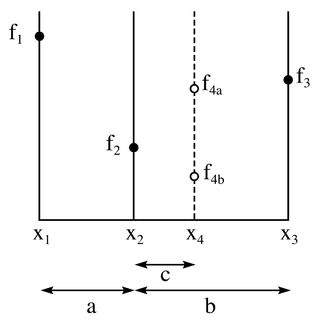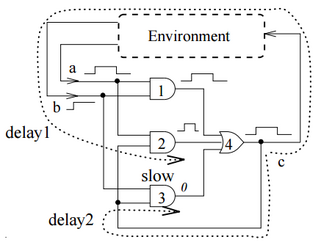Related Research Articles
In logic and computer science, the Boolean satisfiability problem (sometimes called propositional satisfiability problem and abbreviated SATISFIABILITY, SAT or B-SAT) is the problem of determining if there exists an interpretation that satisfies a given Boolean formula. In other words, it asks whether the variables of a given Boolean formula can be consistently replaced by the values TRUE or FALSE in such a way that the formula evaluates to TRUE. If this is the case, the formula is called satisfiable. On the other hand, if no such assignment exists, the function expressed by the formula is FALSE for all possible variable assignments and the formula is unsatisfiable. For example, the formula "a AND NOT b" is satisfiable because one can find the values a = TRUE and b = FALSE, which make (a AND NOT b) = TRUE. In contrast, "a AND NOT a" is unsatisfiable.
First-order logic—also known as predicate logic, quantificational logic, and first-order predicate calculus—is a collection of formal systems used in mathematics, philosophy, linguistics, and computer science. First-order logic uses quantified variables over non-logical objects, and allows the use of sentences that contain variables, so that rather than propositions such as "Socrates is a man", one can have expressions in the form "there exists x such that x is Socrates and x is a man", where "there exists" is a quantifier, while x is a variable. This distinguishes it from propositional logic, which does not use quantifiers or relations; in this sense, propositional logic is the foundation of first-order logic.
In computability theory, a primitive recursive function is, roughly speaking, a function that can be computed by a computer program whose loops are all "for" loops. Primitive recursive functions form a strict subset of those general recursive functions that are also total functions.
In logic, mathematics, and computer science, arity is the number of arguments or operands taken by a function, operation or relation. In mathematics, arity may also be called rank, but this word can have many other meanings. In logic and philosophy, arity may also be called adicity and degree. In linguistics, it is usually named valency.
In computational complexity theory, a decision problem is PSPACE-complete if it can be solved using an amount of memory that is polynomial in the input length and if every other problem that can be solved in polynomial space can be transformed to it in polynomial time. The problems that are PSPACE-complete can be thought of as the hardest problems in PSPACE, the class of decision problems solvable in polynomial space, because a solution to any one such problem could easily be used to solve any other problem in PSPACE.

In logic and mathematics, the logical biconditional, also known as material biconditional or equivalence or biimplication or bientailment, is the logical connective used to conjoin two statements and to form the statement " if and only if ", where is known as the antecedent, and the consequent.
In mathematical logic, a predicate variable is a predicate letter which functions as a "placeholder" for a relation, but which has not been specifically assigned any particular relation. Common symbols for denoting predicate variables include capital roman letters such as , and , or lower case roman letters, e.g., . In first-order logic, they can be more properly called metalinguistic variables. In higher-order logic, predicate variables correspond to propositional variables which can stand for well-formed formulas of the same logic, and such variables can be quantified by means of second-order quantifiers.
The man or boy test was proposed by computer scientist Donald Knuth as a means of evaluating implementations of the ALGOL 60 programming language. The aim of the test was to distinguish compilers that correctly implemented "recursion and non-local references" from those that did not.
There are quite a few ALGOL60 translators in existence which have been designed to handle recursion and non-local references properly, and I thought perhaps a little test-program may be of value. Hence I have written the following simple routine, which may separate the man-compilers from the boy-compilers.

The golden-section search is a technique for finding an extremum of a function inside a specified interval. For a strictly unimodal function with an extremum inside the interval, it will find that extremum, while for an interval containing multiple extrema, it will converge to one of them. If the only extremum on the interval is on a boundary of the interval, it will converge to that boundary point. The method operates by successively narrowing the range of values on the specified interval, which makes it relatively slow, but very robust. The technique derives its name from the fact that the algorithm maintains the function values for four points whose three interval widths are in the ratio φ:1:φ, where φ is the golden ratio. These ratios are maintained for each iteration and are maximally efficient. Excepting boundary points, when searching for a minimum, the central point is always less than or equal to the outer points, assuring that a minimum is contained between the outer points. The converse is true when searching for a maximum. The algorithm is the limit of Fibonacci search for many function evaluations. Fibonacci search and golden-section search were discovered by Kiefer (1953).

In digital computing, the Muller C-element is a small binary logic circuit widely used in design of asynchronous circuits and systems. It outputs 0 when all inputs are 0, it outputs 1 when all inputs are 1, and it retains its output state otherwise. It was specified formally in 1955 by David E. Muller and first used in ILLIAC II computer. In terms of the theory of lattices, the C-element is a semimodular distributive circuit, whose operation in time is described by a Hasse diagram. The C-element is closely related to the rendezvous and join elements, where an input is not allowed to change twice in succession. In some cases, when relations between delays are known, the C-element can be realized as a sum-of-product (SOP) circuit. Earlier techniques for implementing the C-element include Schmitt trigger, Eccles-Jordan flip-flop and last moving point flip-flop.
Seediq, also known as Sediq, Taroko, is an Atayalic language spoken in the mountains of Northern Taiwan by the Seediq and Taroko people.
The Semantic Web Rule Language (SWRL) is a proposed language for the Semantic Web that can be used to express rules as well as logic, combining OWL DL or OWL Lite with a subset of the Rule Markup Language.
The grammar of Lojban is based on predicate logic. The majority of the grammar is borrowed from the prior "logical language" Loglan, and some of its features come from Láadan. The characteristic regularity, unambiguity, and versatility of Lojban grammar owes much to modern linguistics and computer programming—resources that were unavailable to the designers of earlier languages. Lojbanist Bob LeChevalier summarized one advantage of Lojban grammar as follows: "Lojban moves beyond the restrictions of European grammar. It overtly incorporates linguistic universals, building in what is needed to support the expressivity of the whole variety of natural languages, including non-European ones."
In mathematical logic, predicate functor logic (PFL) is one of several ways to express first-order logic by purely algebraic means, i.e., without quantified variables. PFL employs a small number of algebraic devices called predicate functors that operate on terms to yield terms. PFL is mostly the invention of the logician and philosopher Willard Quine.
Correlation attacks are a class of cryptographic known-plaintext attacks for breaking stream ciphers whose keystreams are generated by combining the output of several linear-feedback shift registers (LFSRs) using a Boolean function. Correlation attacks exploit a statistical weakness that arises from the specific Boolean function chosen for the keystream. While some Boolean functions are vulnerable to correlation attacks, stream ciphers generated using such functions are not inherently insecure.
The Tseytin transformation, alternatively written Tseitin transformation, takes as input an arbitrary combinatorial logic circuit and produces an equisatisfiable boolean formula in conjunctive normal form (CNF). The length of the formula is linear in the size of the circuit. Input vectors that make the circuit output "true" are in 1-to-1 correspondence with assignments that satisfy the formula. This reduces the problem of circuit satisfiability on any circuit to the satisfiability problem on 3-CNF formulas. It was discovered by the Russian scientist Grigori Tseitin.
Logic learning machine (LLM) is a machine learning method based on the generation of intelligible rules. LLM is an efficient implementation of the Switching Neural Network (SNN) paradigm, developed by Marco Muselli, Senior Researcher at the Italian National Research Council CNR-IEIIT in Genoa.
In theoretical computer science and formal language theory, a tree transducer (TT) is an abstract machine taking as input a tree, and generating output – generally other trees, but models producing words or other structures exist. Roughly speaking, tree transducers extend tree automata in the same way that word transducers extend word automata.
A spatial join is an operation in a geographic information system (GIS) or spatial database that combines the attribute tables of two spatial layers based on a desired spatial relation between their geometries. It is similar to the table join operation in relational databases in merging two tables, but each pair of rows is correlated based on some form of matching location rather than a common key value. It is also similar to vector overlay operations common in GIS software such as Intersect and Union in merging two spatial datasets, but the output does not contain a composite geometry, only merged attributes.
Belief merging, also called belief fusion or propositional belief merging, is a process in which an individual agent aggregates possibly conflicting pieces of information, expressed in logical formulae, into a consistent knowledge-base. Applications include combining conflicting sensor information received by the same agent and combining multiple databases to build an expert system. It also has applications in multi-agent systems.
References
- Vasile Rus (2002). Logic Form for WordNet Glosses. Ph.D. thesis, Southern Methodist University.
- Vasile Rus and Dan Moldovan (September 2002). "High performance logic form transformation". International Journal on Artificial Intelligence Tools. 11 (3): 437–454. doi:10.1142/S0218213002000976.
- Dan Moldovan and Vasile Rus (2001). "Logic Form transformation of wordNet and its Applicability to question answering". Proceedings of ACL 2001, Toulouse, France. Archived from the original on 2006-09-13.
- Jerry R. Hobbs (1986). "Overview of the TACITUS project". Computational Linguistics. pp. 12(3).
- Vasile Rus (2004). "A First Evaluation of Logic Form Identification Systems" (PDF). SENSEVAL-3: Third International Workshop on the Evaluation of Systems for the Semantic Analysis of Text. Archived from the original (PDF) on 2005-11-03.